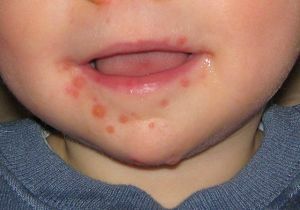 To understand why enterovirus vesicular stomatitis develops with exanthema and how it should be treated, you should know what type of disease differs from other forms and what is exanthema.
To understand why enterovirus vesicular stomatitis develops with exanthema and how it should be treated, you should know what type of disease differs from other forms and what is exanthema.
Vesicular stomatitis is a painful condition provoked by a viral infection, which is therefore characterized by high initial aggressiveness of the process and unpredictability of the result of treatment.
The most unlikely outcome( with the greatest success of therapy) is the complete destruction of the virus by the body, the most frequent - the virus is only suppressed by it and goes into a sleeping( waiting) state. To activate with a favorable for your life, a combination of circumstances - weakening the protection of the body as a result of unfavorable climate, stress and other similar situations.
The disease is caused by the incredible survivability of enteroviruses and their ability to maintain their properties under the most unfavorable conditions:
- in water that has not reached the boiling stage;
- in the sun with insufficiently active radiation;
- in a highly acidic environment.
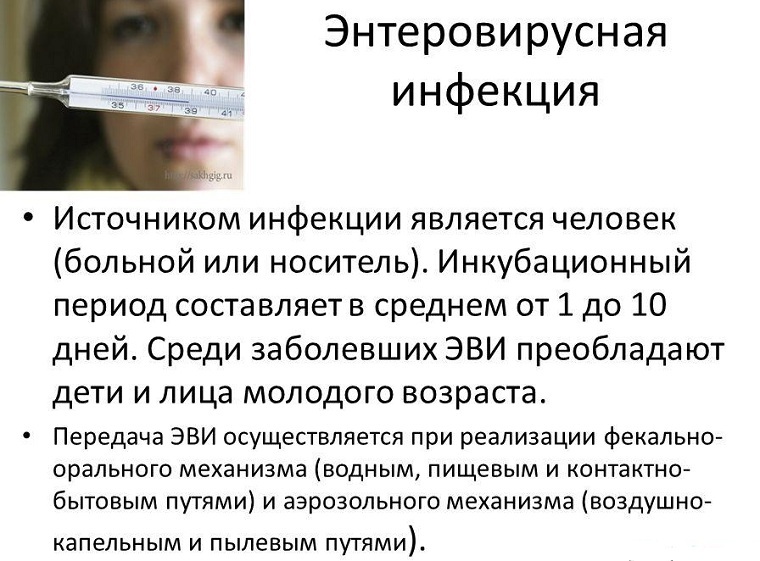
In a word, in all cases when the external temperature or other environmental parameters are insufficient to denature their protein. When such conditions are created, they are almost incompatible with the life of the human body.
Thus, it seems that what happened in a deep childhood( in 2-3 years) infection continues in the adult life of the patient under a different face, most it is dangerous when the virus infection is consolidated with a chronic microbial.
The second half of the name - exantheme is associated with the appearance of typical rash-bubbles in the disease, and not only in the oral cavity, but also on the feet and palms of the patient, so the disease is also called "hand-foot-mouth" syndrome.
Contents
- What causes the disease and is it dangerous
- Clinical features and diagnostic complexity
- Treatment and possible consequences
- About prevention measures
What triggers the disease and is it dangerous
Observed mainly in young children with a peak incidence in the spring and autumn( in view ofincrease in temperature or humidity), the infectious process is initiated:
- by the Coxsackie virus;
- by enterovirus 71;
- less important group of enteroviruses.
Especially distinguished from the whole set of enteroviruses, the species Coxsaki( from the family of picarnoviruses), having 29 serotypes of groups A, B and C, is most significant not only for the occurrence of the "hand-foot-mouth syndrome", but also causes aseptic meningitis. The most dangerous are the Coxsaki serovars A5, A9, A16.
As for enterovirus 71, infectiousness is the destiny of countries with extremely low sanitary culture, in Europe it is almost eradicated as a species.
The disease is of little relevance for adults, but for children with their propensity to drag all "extracted" into the mouth is a serious danger.
The risk of infection for both children and adults is increased in the following cases:
- violation of the rules of cooking( insufficiently long heat treatment or complete absence thereof) or storage conditions;
- existence of microdamages in the oral cavity.
In the first case, enterovirus infection, multiplying in the intestine of the infected( hence the name of the virus: enteros - intestine), spreads with the current of biological fluids, in the second - the infection directly penetrates into the mucous membrane.
With the bites of bloodsucker insects, the entry of the pathogen begins directly into the blood of a healthy person.
Like any intestinal infection, enterovirus vesicular stomatitis is a "disease of unwashed hands", when a fecal-oral mechanism of infection is realized in the care of pets and livestock( less often when working with contaminated laboratory material).
The virus is able to be transmitted and airborne from a sick person to a healthy and contact( through contaminated objects).

Clinic features and diagnostic complexity
The appearance of exanthema is the main difference of this form of stomatitis from its other varieties.
Vesiculovirus( from the term: vesicle - vesicle) that has got into the human body from the external environment, from an animal or a patient, having a special selective activity against the skin and mucous membranes, causes the formation from their surface layers of an insignificant size of the formed elements - a rash in the form of vesicles,filled with serous contents.
They are localized on the surfaces of the lips and cheeks( both internal and external), and also on the back of the tongue( less often in the pharynx).But the main feature, valuable for diagnostics, is their detection on the palms and feet of the patient( more often - the child).
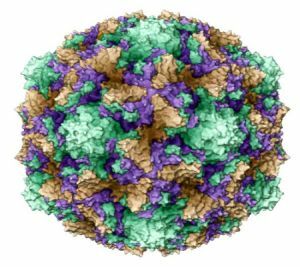
On the photo, Coxsackie enterovirus under the
microscope Evolution of the rashes on the patient's skin passes swiftly from stains or papules of small sizes, having different shades of pink or red, to vesicles with a clear or slightly yellowish liquid. For the virus "hand-foot-mouth" is characterized by an elongated shape of the vesicles.
Vesicular stomatitis manifests itself as swelling and hyperemia of the soft tissues of the mouth: lips, cheeks, tongue, and the appearance on them of blisters of a grayish shade with considerable itching in the areas of rashes, or damage to the mucous to the formation of small ulcers, may be accompanied by excessive salivation.
In rare cases, the rash appears only on the oral mucosa, causing it to differentiate the disease from Stephen-Jones syndrome, aphthous stomatitis, herpes.
If the blisters on the palms and soles are not opened, then with the other localization of the rash, the exposed elements leave noticeable and sensitive erosion. In the process of developing a painful condition, all the damaged areas, covered with crusts, heal without leaving scars.
The problem is that exanthema is by no means the first symptom of enterovirus vesicular stomatitis, whose debut does not differ from the beginning of any JVI.
For the very beginning of the disease is characterized by: 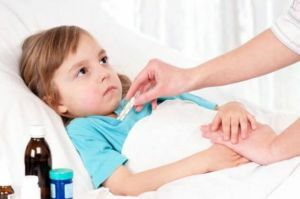
- raising the temperature to critical digits( up to 40⁰ C and above);
- photophobia and pain accompanying the movement of the eyeballs;
- difficulty in swallowing and pain in its implementation;
- nausea and vomiting of cerebral genesis, together with headaches, apathy, lethargy and weakness.
Other common signs are:
- pains and spasms in the muscles( including the stomach);
- diarrhea;
- submandibular and cervical lymphadenitis;
- sore throat;
- runny nose.
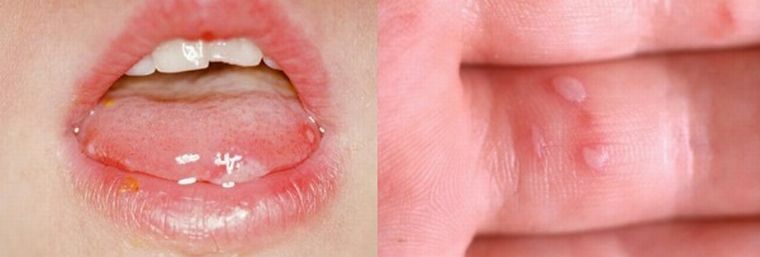
In the photo the vesicles in the mouth and on the hands are a characteristic sign of enterovirus infection
The use of various symptomatic agents for treatment also lubricates the clinic of the disease, which is why inexperienced doctors often expose incorrect diagnoses from ARD and teething to dermatitis, allergy and herpetic infection.
Coxsackie virus entering the human body with a sufficiently high immune defense leads to the absence of a disease clinic( asymptomatic variant) or to the course of the condition in a mild, worn out form.
Infectiousness for others is decreasing in proportion to the period from the onset of the disease( in the first day it is maximal), but the isolation of enteroviruses with feces can last up to a month from the moment of debut of the disease.
Despite the fact that there is nothing specific in the clinic, the appearance of vesicles on the limbs, roughly on the third day of the debut of the disease( which is completely resolved in a period of seven to ten days), makes it possible to make a diagnosis with confidence. With

, enzyme immunoassay is an effective way to detect the "hand-foot-mouth." Syndrome.
disease recognition should take into account the duration of the incubation period - with enterovirus infection it is from 2 to 7 days.
For the purpose of a diagnostic study, or in case of an outbreak of an epidemic with a mass lesion of a large number of children, virological methods for laboratory diagnostics with the study of biological material containing viruses are used to rapidly develop an antiepidemic action strategy:
- electronic( and immune electronic) microscopy;
- ELISA( enzyme immunoassay);
- RIA( radioimmunoassay);
- PCR( polymerase chain reaction) and similar diagnostic methods.
The contents of vesicles, feces, blood, nasopharyngeal wash serve as a material for isolating, studying and identifying the virus.
Treatment and possible consequences
The patient should be necessarily isolated and examined by a doctor, and the diagnosed and recognized enteroviral vesicular stomatitis is treated by applying local and general effects on the body.
In order to reduce local manifestations of the condition( pain, itching, edema), anesthetics are used:
- in the lidocaine category;
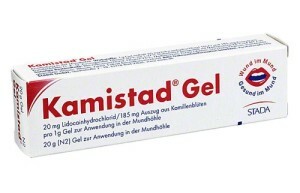
- combined Kamistad-gel containing chamomile extract and lidocaine - anesthetic-antiseptic with anti-inflammatory effect;
- Asepta( children contraindicated);
- antiseptic-anesthetic. Hexoral.
To local remedies that help accelerate the healing of tissues and restore their structure, include:
- Propolis spray - a natural antiviral-anti-inflammatory and antiseptic formulation( used with individual tolerability);
- oil solution Carotolin - accelerator of tissue regeneration due to a powerful antioxidant effect, which increases the body's resistance to infections;
- Imudon , activating phagocytosis and increasing the concentration of immunoglobulin A in saliva produced.
As local antiviral drugs, it is advisable to use ointments:
- oxolinic;
- is tebrofen.
In severe cases, general treatment may be required:
- antipyretic procedures and antipyretic drugs;
- rinsings with herbal decoctions: lime blossom, yarrow, chamomile, St. John's wort, eucalyptus, burdock to relieve pain in the throat.
Despite the comparative harmlessness of the disease, with the connivance of parents, it can lead to complications due to the trophicity of the virus not only to the mucous membranes and skin, but also to the structures that make up the nervous system:
- to encephalitis;
- for meningitis;
- to acute and sluggish paresis.
About prevention measures
Despite the fact that the once transferred disease is never repeated in the "one-in-one" variant, enterovirus infection in the inactive state remains in it for many years. Therefore, it is more reasonable to take some measures to prevent the virus from entering the body.
This is an elementary compliance with hygiene standards: washing hands, brushing teeth, rinsing your mouth after eating, using clean water for your needs, isolating the sick, using only individual( preferably one-time) hygiene products.
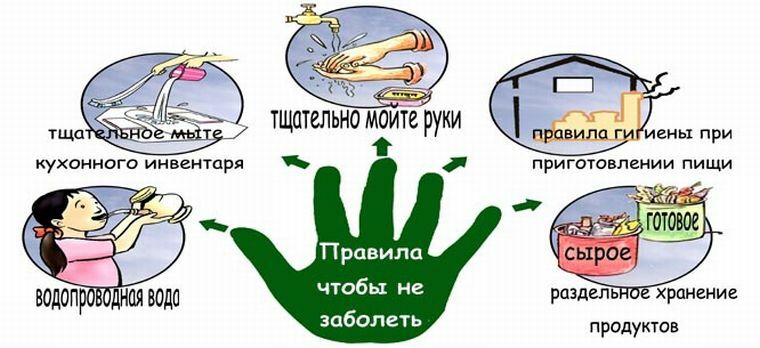
Prevention of enterovirus infection
Measures to strengthen immunity and achieve good health are also elementary: a fairly mobile way of life without food and other excesses, vitamins of natural origin( vegetables, fruits), mandatory intake of immunomodulators in peak incidence of influenza and ARVI.
Livestock workers need strict adherence to veterinary requirements for animal welfare and personal hygiene.
Small animals do not usually present danger to humans under the appropriate conditions of life.
In case of suspicion of infection, a visit to the doctor should be mandatory, not depending on the age of the patient, because he can become dangerous to his environment.
